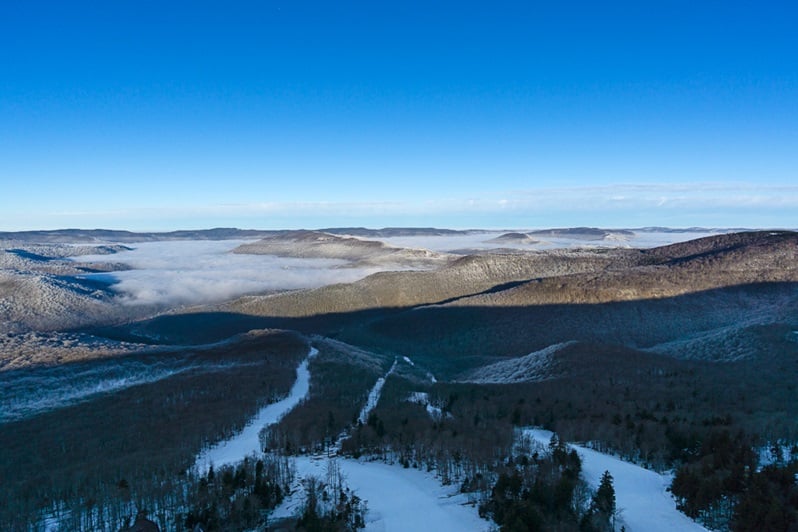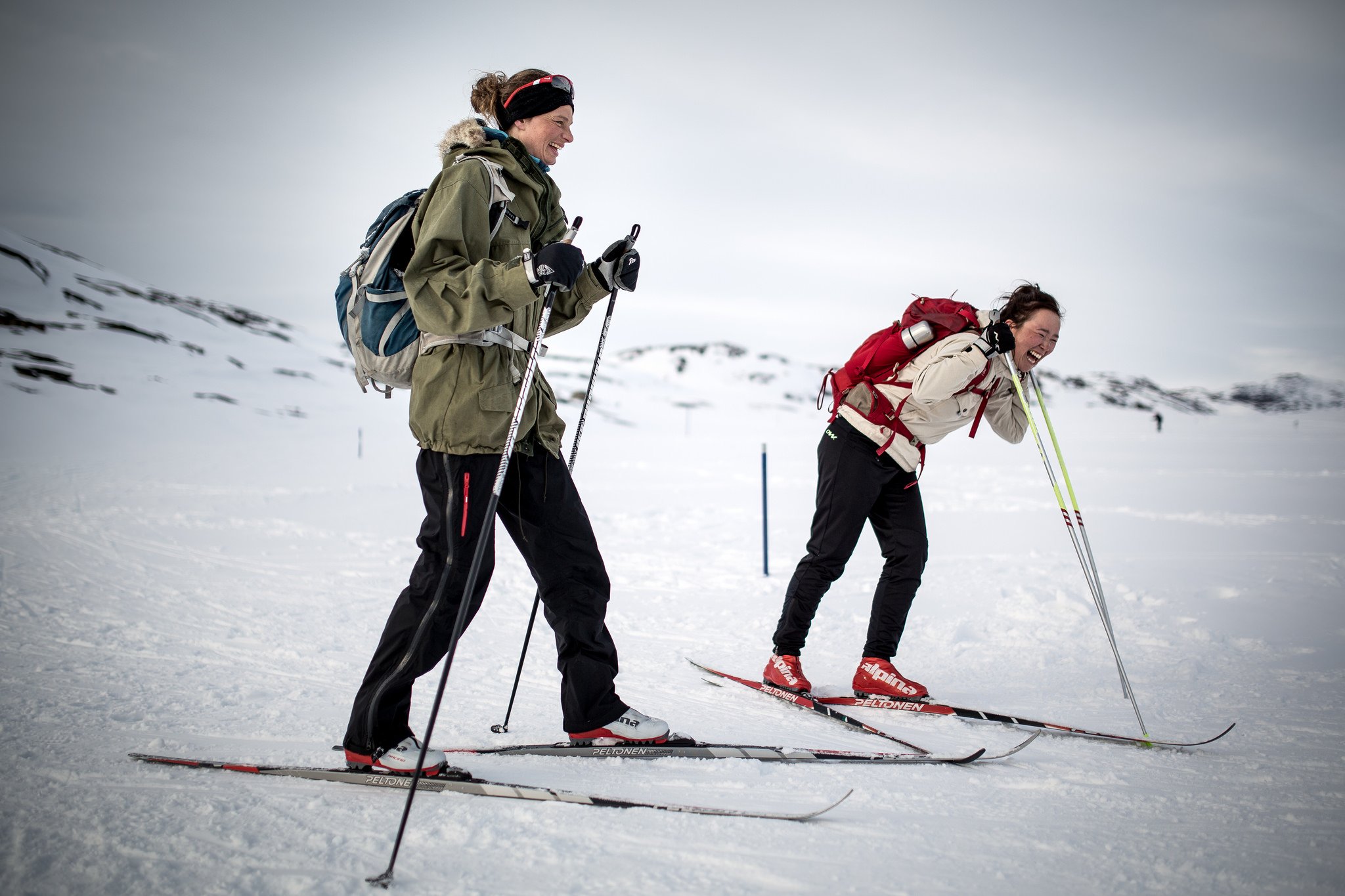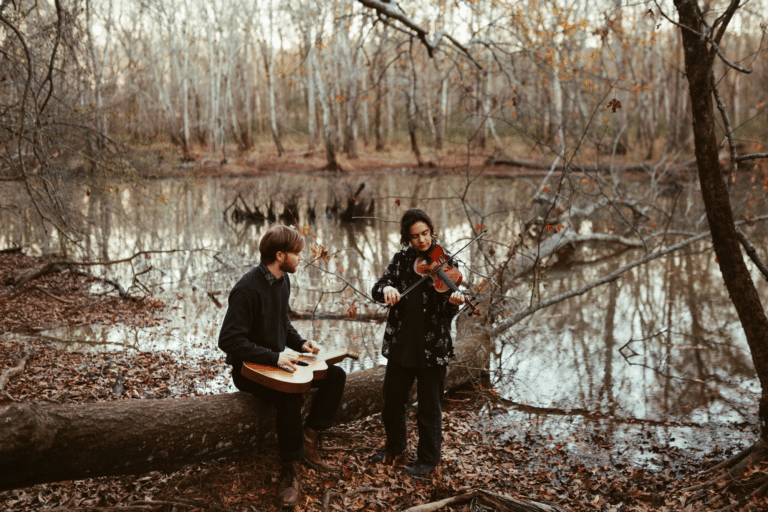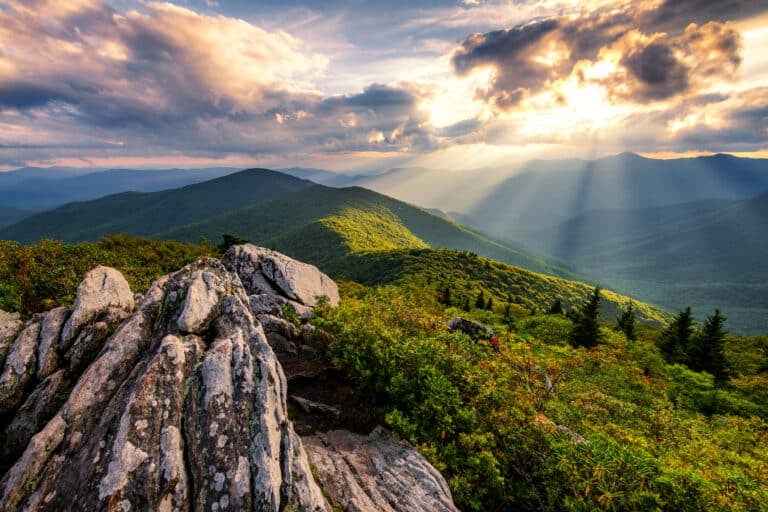The first thing you have to do is forget about the man in full body spandex. The one kicking and gliding through the snow on skinny skis at great speeds. This is probably the image that pops into your head when someone says “cross-country skiing.” You think of some ridiculously skinny man trying to break land-speed records on flat ground. This is “skating,” the cross-country skiing that gets airtime during the winter Olympics. This is the cross-country skiing of Biathlons, where skiers strap rifles to their backs in order to perform a bizarre ski/shoot duet. This is the cross-country skiing that made it into the Bond movie where Roger Moore is chased down by a crazed Biathlete on the payroll of some criminal kingpin. And this is exactly the kind of cross-country skiing that keeps people from ever wanting to try cross-country skiing.
“Everybody barfing at the finish line and then some announcer saying cross-country is the most arduous sport on the planet?” says Chip Chase, owner of Whitegrass Touring Center in Canaan Valley, West Virginia, the Mid-Atlantic’s premiere cross-country destination. “The cross-country industry has painted themselves into a corner where everybody thinks skating is cross-country skiing, but it’s not. Skaters are a bunch of nerds. They’re a bunch of accountants, no offense to the accountants out there. What we do at Whitegrass has nothing to do with skating.”
At first, you’re not going to believe what Chase and a portion of his clientele do at Whitegrass. When I tell you that these skiers bomb steeps, huck boulders, and thread tree runs, you’re not going to believe me, because they do it all on cross-country gear. While skating gets all the press and TV time, there’s a small sect of cross-country skiers that use those long, skinny skis made for kicking and gliding across gentle meadows of snow and traversing hills to shred every inch of vertical drop their local mountains can dish out. The younger generation is even taking their cross-country gear to the terrain park.
Search and Destroy
“We want to crash and explore,” Chase says. “We want elevation changes and we want to make the most of the terrain. We want to ski it all and we want to do it on cross-country gear.”
Some call it new-school cross-country, some call it free-country, others call it extreme Nordic, whatever name you give it, new life has been breathed into cross-country skiing in the last few years. It’s a brave new world where anything on skinny skis is possible and the whole world is a terrain park.
Traditional cross-country gear is blissfully simple. The skis are long, skinny, and light. The binding isn’t much more than a bar that hooks into the toe of your boot, which is usually leather, lightweight and comfortable, and all of it together weighs about as much as a pair of feathers. Going from your standard new-school downhill gear (which is increasingly heavy and fat) to cross-country gear for the first time is like having gastro-intestinal surgery. You’re so light on your feet, you feel like you can do anything-which is a bit misleading, because cross-country is all about balance and technique. The gear in downhill does a good job of covering for any faults in your skiing technique. The fatter the skis get, the less you actually have to know how to ski. With cross-country gear on your feet, however, you’re naked: your skiing ability and all its shortcomings are on full display. Just about anyone can strap on a pair of touring skis and glide through the snow on level terrain right off the bat, but throw a downhill in the mix and you’ve got to learn how to ski all over again. When you first strap them on, it’s hard to believe there are kids out there that hit tree runs and half-pipes with these skinny sticks strapped to their feet.
“It takes more skill to traverse and ski the fall line with touring gear,” Chase says. “The skis don’t give you an advantage or offer a lot of support, so you have to rely on balance and technique.”
Which is probably why so few people ever try anything more demanding than cruising through a meadow with cross-country skis. Mike Dreisbach owns Savage River Lodge, a cross-country resort in Maryland, and sees people succumb to their perceived limitations of cross-country gear all the time. “Most people stick to the valley roads and trails when they come here,” Dreisbach says, even though his lodge sits next to Mount Aetna, which has 1,500 feet of vertical drop and plenty of snow. “There’s so much skiable terrain on that mountain. You can ski all day and never hit the same place twice. But there are only a few backcountry skiers that ever explore it.”
More and more, the backcountry skiers that do explore the vertical lines of mountains like Aetna are doing it with traditional cross-country gear. In the past, the gear of choice for this sort of skiing has been telemark skis, which offer the same free-heel movement of cross-country gear, but are wider and more stable. Climbing in telemark gear isn’t as efficient as in cross-country gear, but the wider ski gives the user more control on the downhills. It’s a tradeoff. A tradeoff that a young generation of skiers is no longer willing to make. They still want to hit the backcountry lines, but they want to do it with the lightest gear possible.
“To me, there’s no difference between telemark, cross-country, or downhill,” says Morgan Chase, Chip Chase’s 17-year-old son. “I’m always on cross-country gear, no matter what I’m skiing.”
Morgan and his two brothers, Adam and Cory, are part of a new breed of skier who are simultaneously drawn to the adrenaline-soaked freeskiing/terrain park movement and the lightweight practicality of cross-country gear.
“You can get across terrain faster on cross-country gear,” Morgan says. “You can climb easier so you use less energy in the backcountry and can get more runs in. And you can go anywhere on these skis. Telemark and downhill gear is kind of limiting, but cross-country gear is all about freedom.”
Morgan says a number of kids within Canaan Valley are drawn to that sense of unlimited possibilities. “A lot of kids are getting into the same thing around here. Kids are traversing into the backcountry and hitting jumps or boulders. It’s changing the sport.”
Evolution or Lack There Of
The surprising thing about cross-country skiing is that it’s been around for so long: 4,000 years, give or take a year or two. That makes cross-country skiing one of the oldest “sports” in the world, even though, originally, skiing was all about survival. The first skiers most likely used one long ski and one short ski. The long one was for gliding, the short one was for kicking. Sometimes they carried a long pole to help propel them across fields and provide balance. Skiing was how men hunted food. It was how they got from point “A” to point “B” during the long winters in landscapes that are now known as Norway, Finland, and Sweden. It was even a part of their mythology. Ull was a powerful god according to Norse mythology, and one of his greatest contributions was giving mankind the practice of skiing.
The sad thing is, in those 4,000 years since Ull invented skiing, there hasn’t been a whole lot of evolution in the sport of cross-country. Obviously, the gear has improved since the original short/long ski combo, but the scope of the sport hasn’t changed much. It could be argued that the most drastic evolutionary leap didn’t come until the last few years, when young skiers, raised on cross-country skis like the Chase brothers, started hitting the terrain parks and steeps with their skinny skis.
And anywhere you have that coveted target demographic trying something new, you have gear companies ready to capitalize on a fresh market. Last winter, Fischer introduced the Jibskate, the world’s first twin-tip cross-country ski designed to bridge the gap between cross-country devotees and park rats.
“You can hit the park, hit jumps, ski backwards, do a rail slide,” Morgan Chase says. “You can do anything on these ski.”
Salomon also has a line of cross-country skis that blend downhill performance with cross-country climbing ability. They’re fatter than traditional cross-country gear, a little heavier, have metal edges for carving, and allow skiers new to cross-country the ability to hit downhill lines with more efficiency and style.
“Cross-country isn’t just about traipsing across the valley floor anymore,” says Hal Thomson of Salomon. “It’s about going up and down.”
Chip Chase believes West Virginia’s terrain lends itself perfectly to this new-school cross-country scene. “In these parts, you don’t get the snow without high elevations. So if you want to ski, you have to ski elevation. Our valleys don’t get snow, so you have to ski the vertical,” Chase says. “Plus, there are no cliff bands along our mountain ridges, and no avalanches, so it’s safe to ski anywhere. [This region is] the perfect environment for backcountry skiing.”
The question is, will Chase’s form of adrenaline-induced cross-country skiing win Southeastern skiers over? Will we abandon the lift lines and $60 lift tickets to explore the natural terrain parks of the woods on skinny skis?
“Downhill skiing is still pretty new in the South,” Chase says. “But as time goes on, people are more willing to try something different. Once people get bored with traditional downhill, they’ll look for more of a challenge and become more versatile snowsports athletes. It’ll happen in the South, eventually.”
The Great Lakes Effect
“A lot of people don’t realize that western Maryland and West Virginia are inside a Great Lakes Effect snow-belt,” says Mike Dreisbach of Savage River Lodge. “During a good year, we’ll get 160 to 190 inches of snow. Even a bad winter will give us 120 inches.”
What that means for cross-country skiers is more days on the snow. Dreisbach says he got 38 days on the snow last season, which by all accounts was a rather disappointing winter. Normally, he’ll get 50 days of skiing in. In Canaan Valley, Chase has been known to get 120 days of skiing during a single ski season. Even during last year’s warmer than normal winter, Whitegrass saw 100 skiable days.
Contrary to popular belief, snow does exist in the Southeast and Mid-Atlantic. You just have to know where to find it. That’s where BRO comes in. Follow our brief destination guide to find the best natural snow below the Mason Dixon line.
Deep Creek, Western Maryland
Tucked snuggly within that Great Lakes snowbelt, Deep Creek Lake gets so cold and receives so much snow, the community has a long history of dog-sledding and ice fishing. The cross-country skiing ain’t bad either. There are six state parks within the area with cross-country ski trails and a number of guide services and private farms are available for those new to the sport.
Check out Backbone Farm, a cross-country resort that gets 150 inches annually, covering its’ 520 acres of forest and farm.
And Savage River Lodge has 15 miles of trails with 300 feet of elevation change as well as access to Mount Aetna’s 1,500 feet of vertical drop. 120-190 inches of snow, and it’s only 2.5 hours from D.C.
Canaan Valley, West Virginia
The valley is a nationally renown free-heeling destination that attracts the best skiers in the region. People have even been known to move to the valley just for the endless cross-country skiing possibilities.
Whitegrass Touring Center will get you set up with lessons, gear, and guide you through the valley floor or across the mountains. 1,200 vertical feet, 50 kilometers of trails, and 160 inches of snow every year.
Cheat Mountain, West Virginia
The amount of snow this long, tall mountain gets is unfair. Several peaks along its ridge top out above 4,000 feet and each of them has been known to receive upwards of 220 inches of snow in a single season. That rivals the snowfall seen at mountains in Vermont and New Hampshire. It’s not out of the question for Cheat to have a deep, permanent snow-base throughout January and February, making this the most consistent cross-country skiing in the region.
Snowshoe Mountain Resort may be famous for its downhill, but the mountain also boasts 43 kilometers of marked cross-country trails as well. Head out on the Cheat Mountain Ridge Trail to get deep into the backcountry. Cheat Mountain Club offers access to all of Cheat’s snowy bliss, and has played host to some of the most famous men and women in American history. If it was good enough for former presidents and captains of industry, it’s good enough for you too. 304-456-4627.
Cheat Mountain Club offers access to all of Cheat’s snowy bliss, and has played host to some of the most famous men and women in American history. If it was good enough for former presidents and captains of industry, it’s good enough for you too. 304-456-4627.
Located at the base of the Cheat Mountain Range, Elk River Touring Center picks up the majority of the snow that Cheat receives on a yearly basis. The center capitalizes on this fact by offering 5 kilometers of groomed trails on site as well as access to 30 kilometers of trails crisscrossing the backcountry of the Monongahela National Forest.
[divider]related content[/divider]







